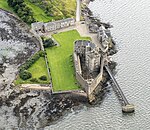DM Crombie
Ammunition dumps in ScotlandInstallations of the Ministry of Defence (United Kingdom)United Kingdom military stubs
Defence Munitions Crombie is a military munitions depot on the upper Firth of Forth in West Fife, Scotland. The depot is located on the north shore of the river, south of the village of Crombie and west of Charlestown. The site commenced operations in 1916. It was formerly known as RNAD Crombie and DMC Crombie. It is now operated as part of the UK's Defence Storage and Distribution Agency.The depot has two jetties and a deep water channel allowing Royal Navy warships and Royal Fleet Auxiliary replenishment vessels to moor for resupply.
Excerpt from the Wikipedia article DM Crombie (License: CC BY-SA 3.0, Authors).DM Crombie
Ordnance Road, Dunfermline
Geographical coordinates (GPS) Address External links Nearby Places Show on map
Geographical coordinates (GPS)
| Latitude | Longitude |
|---|---|
| N 56.040299 ° | E -3.529687 ° |
Address
Defence Munitions Crombie
Ordnance Road
KY12 8LA Dunfermline
Scotland, United Kingdom
Open on Google Maps









